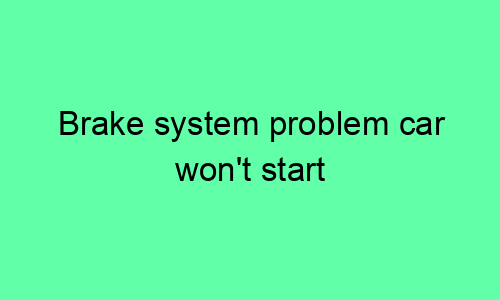## Brake System Problem: Car Won’t Start
### Problem Description
Car owners may encounter a situation where their vehicle fails to start, and one potential cause could be issues with the brake system. When the brake system malfunctions, it can prevent the starter from engaging and starting the engine.
### Causes of Brake System Problem: Car Won’t Start
**1. Faulty Brake Switch:**
The brake switch, located on the brake pedal, signals the starter to engage when the pedal is depressed. A faulty brake switch can interrupt this signal, preventing the starter from receiving the necessary power to start the engine.
**2. Defective Brake Pedal Safety Switch:**
Similar to the brake switch, the brake pedal safety switch ensures that the brake lights are activated when the pedal is depressed. A malfunctioning safety switch can interfere with the starter signal, causing the engine not to start.
**3. Corroded Brake Connections:**
Over time, corrosion can accumulate on electrical connections within the brake system, including the brake switch and starter solenoid. This corrosion can disrupt the flow of electricity, preventing the starter from engaging.
**4. Electrical Faults:**
Electrical faults in the brake system can also lead to starting problems. Short circuits, broken wires, or loose connections can disrupt the communication between the brake components and the starter, resulting in a no-start condition.
### Troubleshooting Steps
To troubleshoot brake system problems that prevent the car from starting, follow these steps:
**1. Check Brake Lights:**
If the brake lights are not illuminating when the pedal is depressed, it could indicate a faulty brake switch or a problem with the brake light circuit.
**2. Depress Brake Pedal:**
While attempting to start the engine, firmly depress the brake pedal and hold it down. If the engine starts in this position, it suggests an issue with the brake switch or safety switch.
**3. Inspect Brake Switch:**
Locate the brake switch on the brake pedal arm and visually inspect it for any damage or corrosion. Test the switch by disconnecting it and using a multimeter to check for continuity.
**4. Check Fuse:**
Locate the fuse responsible for the brake switch or starter circuit and check if it has blown. Replace the fuse if necessary.
### Repairs and Solutions
Depending on the diagnosis, the following repairs may be necessary to resolve the brake system problem and restore normal engine starting:
**1. Replace Brake Switch:**
If the brake switch is faulty, it should be replaced to restore the starter signal.
**2. Repair Brake Pedal Safety Switch:**
If the brake pedal safety switch is malfunctioning, it should be repaired or replaced to ensure proper electrical communication.
**3. Clean Corroded Connections:**
Remove corrosion from electrical connections by using a wire brush or electrical contact cleaner. Tighten any loose connections to improve conductivity.
**4. Repair Electrical Faults:**
Troubleshoot and repair any electrical faults within the brake system, such as short circuits or broken wires.
### Prevention Tips
To prevent brake system problems that affect engine starting, follow these preventative measures:
**1. Regular Brake Fluid Checks:**
Maintain the recommended brake fluid level and replace it regularly as per the manufacturer’s specifications. Brake fluid helps prevent corrosion and lubricates moving parts.
**2. Inspect Brake Pads and Rotors:**
Regularly inspect brake pads and rotors for wear and damage. Replace worn or damaged components before they cause issues with the brake system.
**3. Clean Electrical Connections:**
Periodically inspect and clean electrical connections within the brake system to prevent corrosion and ensure proper electrical communication.
### Conclusion
Brake system problems can result in a car not starting due to issues with the brake switch, brake pedal safety switch, corroded connections, or electrical faults. By understanding the causes and troubleshooting steps, car owners can diagnose and resolve these problems effectively. Regular maintenance and prevention tips can help minimize the chances of encountering such issues and ensure smooth engine starting. It is important to seek professional assistance from a qualified mechanic if the problem persists or if electrical faults are suspected.






